HiFinance
5
SECTION 1.2 - DEBTOR ENQUIRIES
USAGE: To enquire on the Debtor balances and static
information such as the name, balances and notes. To enquire on the
transactions pertaining to an individual Debtor. In both cases, information can
be displayed on the screen or printed. Information cannot be changed by this
option.
DISCUSSION: When you start the enquiry program, the computer will
initially ask for a Debtor code. Enter the code and press <Enter>.
To search for an account, press <F9>.
The following pages describe in full the
procedure for searching for Debtors. The procedure is similar for other files.
If you do not need this detail, skip past the next few pages.
Searching for
a Debtor:
When you are asked for a Debtor code, you have
several options. Initially, HiFinance will display a blank field:
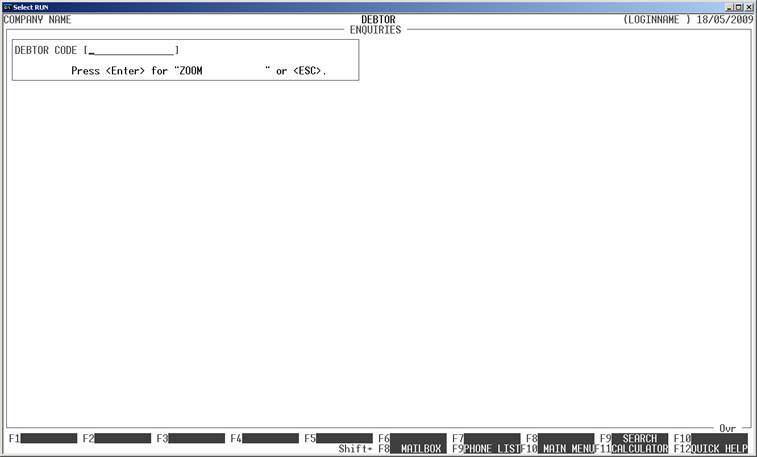
If you have chosen to answer Y to the question CARRY LAST KEY
FROM ONE FUNCTION TO NEXT, in SYSTEM DEFAULTS (see SECTION 6.1.2),
the prompt may inform you that if you press <Enter>, HiFinance will
automatically recall the last Debtor you accessed (in your current session). In
either case, if you press <F9>, you will be taken to the
search screen. If you enter a blank code and you have answered Y to the
question AUTO-SEARCH WHEN KEY DOES
NOT MATCH, this
will have the same effect as pressing <F9>.
The screen will appear as follows:
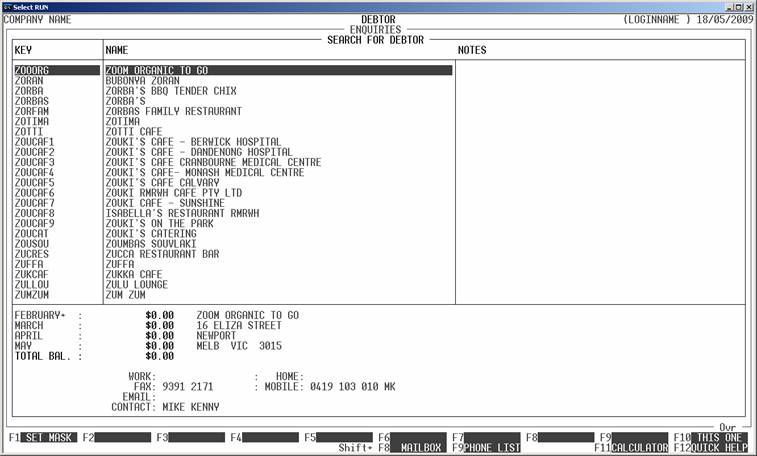
The search will start at either the beginning of the
Debtor file or from any partial code you have entered in the previous screen.
Also, you have the choice to either display the master-file in Debtor code or
Debtor name order. Normally, you should choose Debtor code because the code is
usually an abbreviation of the Debtor’s name. If you have chosen to use a
coding system based on, for instance, sequential numbers, or phone numbers, you
will probably choose to search by name. The choice is made in SYSTEM DEFAULTS.
You will notice that one line has a horizontal line
across it. This is known as the current
line. The current line is the one that is displayed in detail at the bottom
of the screen.
There
are several function keys available in this screen:
<Enter> This will return the Debtor on the current line to the
calling program. In DEBTOR ENQUIRIES,
this Debtor will then be displayed in full.
<F1> This allows you to set a mask so that the search only
looks for Debtors with specific attributes. You can mask by Name and/ Address.
The mask can also be made case-sensitive or not. Once you have set a mask, <F2> is available for you to clear the mask and display
all Debtors (or you can exit and re-enter the program). <F1> is still available once a mask is defined, so that
you can modify your mask attributes. To run, HiFinance needs to first make sure
that there is at least one Debtor that passes the mask test. If you have a
particularly large Debtor file, this may take some time.
<F4> If your USERCODE allows you to modify notes
via the enquiries screen, HiFinance will either display ADD NOTE or AMEND NOTE, depending in wether the
note is currently blank or not, respectively. If you press <F4>, HiFinance will overlay a window that displays the
note attached to this Debtor and allows you to enter your changes.
<F9> This function is only available if you choose to
search in Debtor name order. The purpose of this key is to open up a window
that allows you to enter a partial name for the program to start the search
from. Enter the new starting point and press <Enter>.
<F10> This has the same function as <Enter>, above.
<ESC> This will abort the search and return you to the
Debtor code entry screen.
<CsrUp> This will move the current line up by one. If you are
already on the first entry, the computer will beep and the highlight bar will
not move.
<CsrDn> This will move the current line down by one. If you are
already on the last entry, the computer will beep and the highlight bar will
not move.
<PgUp> This will cause the search screen to attempt to move one
page up. If you are already at the top of the file, the highlight bar will not
move. If you are at the bottom of the screen, the highlight bar will move to
the top. If you are anywhere else, the screen will display one page of Debtor
records backwards, without moving the highlight bar (unless you have reached the
start of the Debtor’s master-file).
<PgDn> This will cause the search screen to attempt to move one
page down. If you are already at the end of the file, the highlight bar will
not move. If you are at the top of the screen, the highlight bar will move to
the bottom. If you are anywhere else, the screen will display one page of
Debtor records forwards, without moving the highlight bar (unless you have
reached the end of the Debtor’s master-file).
<Home> This will move the highlight bar to the top of the screen
and make the first Debtor the current line.
<End> This will move the highlight bar to the bottom of the
screen (if there are enough entries to fill the screen) and make the last
Debtor the current line.
<A-Z> If you enter a letter (in upper or lower case), the
search will move directly to the first Debtor that starts with that letter.
<The Mouse> In search screens, HiFinance allows you to use the mouse to move
around the screen. If you click on the current line, this will have the same
effect as <F10>. Clicking on any other
record will move the highlight bar to that line. Therefore double clicking on a
line will choose that line and return it to the ENQUIRY program. If you click outside the main window, the effect
will be the same as <CsrUp> or <CsrDn> depending on whether you click above or below the
window.
Displaying
Debtor Information.
Having entered a valid code, the computer will
display the current information pertaining to that Debtor. The information is
on several pages. The first page appears as follows:
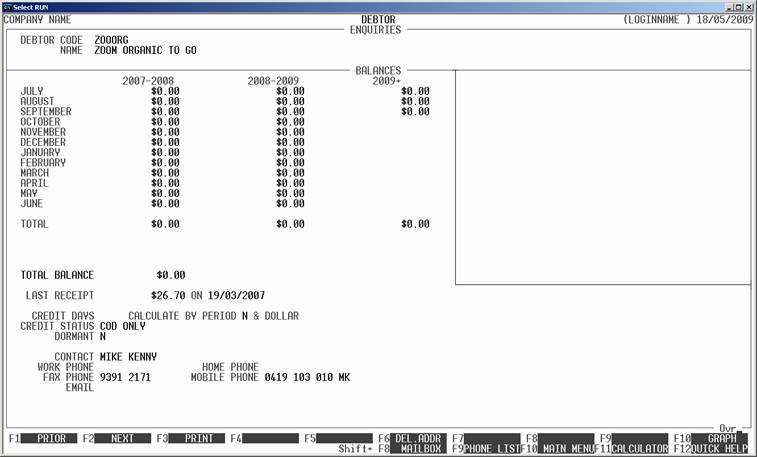
The top of the screen displays the Debtor code and
name. This first page normally displays the outstanding balances for each
accounting period in this year and last year. In some installations there are also
other columns of information. There is a total for each column at its base. The
box to the right of the screen displays the notes applicable to this Debtor.
You will have several options available via the
function keys:
<F1> or <CsrLeft> This
will cause HiFinance attempt to read the previous record. If there is one, it
will be displayed.
<F2> or <CsrRight> This
will cause HiFinance attempt to read the next record. If there is one, it will
be displayed.
<F3> will print the information currently on the screen.
Before printing the computer will ask, START
REPORT? To
start the report, answer Y. If you do not wish to
print, answer N. More information is
printed on this report than appears on the screen. You will be given the option
(via function keys) to either print the details of the Debtor, ie all the
fields that you see on the screen, but in a report format (<F1>), or a single statement for the current Debtor (<F3>). If this Debtor has at least one transaction, you
will be given the option to REPRINT (<F5>) a range of Invoices (and
Credit-notes). This option is useful if you wish to quickly reprint a range of
invoices for a client without having to initiate them one by one. If you have
the RE-ORDER FORM option installed, <F6> will allow you to generate
an re-order form for the current Debtor.
<F4> If your USERCODE allows you to modify notes
via the enquiries screen, HiFinance will either display ADD NOTE or AMEND NOTE, depending in wether the
note is currently blank or not, respectively. If you press <F4>, HiFinance will overlay a
window that displays the note attached to this Debtor and allows you to enter
your changes. If your USERCODE does not allow this option, only VIEW NOTE will appear, and only if the note is not blank.
<F5> will allow you to display transactions for this
account. The screen will highlight the current balance. See below for a full
description of this function. If there are Invoices or Credit Notes on file for
this Debtor, there are also likely to be Inventory transactions available. If
this is the case, when you have chosen a period to display, you will then be
given the choice of displaying Debtor transactions or Inventory transactions.
This is determined by you pressing <F4> or <F6>, respectively. If you choose <F6>, only Inventory transactions pertaining to the
current Debtor will be displayed. This is a quick way of finding out what a
customer has bought in the past and is often more efficient than using the INVENTORY TRANSACTION REPORTS function
(see SECTION 3.4.9).
<F6> This overlays a window that displays the Delivery
Address attached to this Debtor. If there is no Delivery Address, the function
key is not active.
<F7> This overlays a window that displays the Delivery
Instructions attached to this Debtor. If there is no Delivery Instructions, the
function key is not active.
<F8> will allow you to display sales orders for this
account. The functionality of this option is similar to displaying transactions
<F5>.
<F9> If you have chosen to enable labels, <F9> will be displayed. Pressing this will cause the
program to enter the label routine. The exact label routine entered depends on
your choice in SYSTEM DEFAULTS. The
default label routine prints on single file labels 1 ˝” deep (top of one to top
of the next) and 3 ˝” wide. The routine will ask you if how many labels you
require. If you choose zero, the routine will exit. If you choose a number
greater than 1, the labels will be printed, 1
of X, 2 of X, etc. Labels are printed to the printer defined in ASSIGN LOCAL PRINTERS, see SECTION 7.1.3.1.
<F10> This will option will send the information on the
screen to a special program that formats it into a vertical bar graph. The
graph shows all periods, separating the years with colours. In the standard
colour scheme, last-year is in yellow, this-year is in red and next year (if
not zero) is in green. In either case, the legend is displayed near the
top-right-hand corner of the screen. The vertical axis is self-scaling. You
actually have the choice of displaying a graph of the current outstanding
balances or the sales per period, by pressing <F9>
or <F8>, respectively.
<ESC> will return to Debtor code entry routine. From
there, another <ESC> will exit the program and
return you to the DEBTOR enquiry MENU.
Initiating Debtor
Transactions.
If there are any Debtor transactions available for
this Debtor, <F5> will be displayed. When you
press <F5> the screen will appear as
follows:
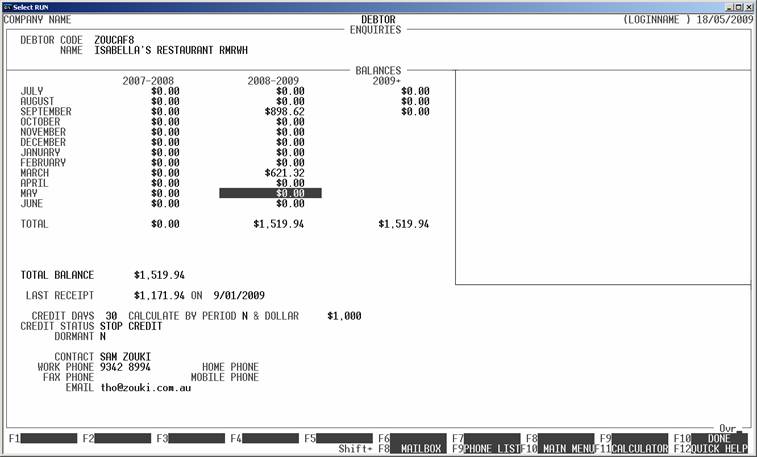
The balance corresponding to the current month is
highlighted. When you press <Enter> or <F10>, HiFinance will move to the Transaction Display
program. This program will attempt start to display transactions from the
highlighted period. If you wish to display transactions for another period, use
the cursor keys to move the highlight to that period, and then press <Enter> or <F10>. If you are using the
mouse, clicking on a period will immediately start the transaction display from
that period.
Choosing the Transaction File.
HiFinance does a quick check to see what information is available for the current Debtor. At this point, there could be Debtor transactions, eg Invoices, Receipts, etc. and there could also be Inventory transactions, ie purchases and returns, on the Inventory transaction file. If both exist, you will need to choose. The screen will display two function keys, <F4> for Debtors and <F6> for Inventory. You will need to press one of these to proceed, or <ESC> to go back to previous screen.
Displaying Debtor
Transactions.
Having chosen a period, the display program will
start up. Initially you will be asked if you wish to limit the display to
active transactions. If you only wish to display transactions that are
outstanding, eg INVOICES, etc.,
choose Y. If you choose N, all transactions will be displayed. The screen will appear as
follows:
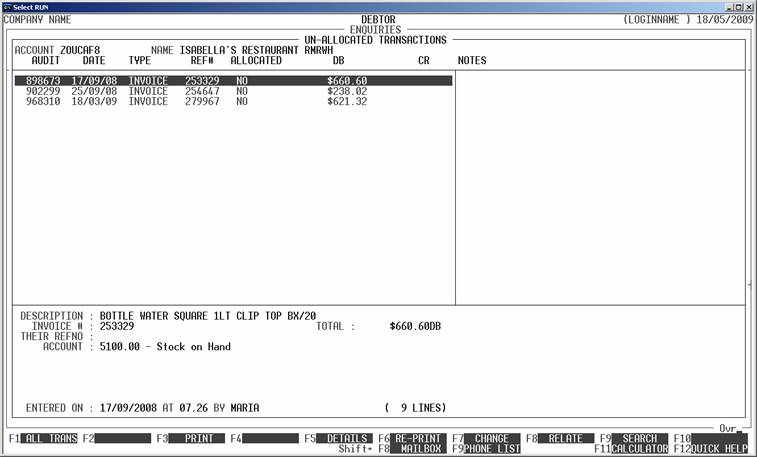
Moving around this screen is similar to searching
for a Debtor. This is fully described above. You will also have several options
available via the function keys:
<F1> If you have chosen to display only active
transactions, pressing <F1> will switch to displaying
all transactions. There is no way of switching back without pressing <ESC> and re-entering the function. You will notice that
when displaying active transactions, the body of the screen displays the amount
outstanding only, and the details window displays the total value of the
current transaction. When you display all transactions, this is reversed.
<F3> This will cause HiFinance to initiate a print of
the transactions for this Debtor. Note that main accounts will include all
transactions for their subsidiary accounts. Sub-accounts will only display and
print transactions assigned to them (normally only INVOICES and CREDIT-NOTES).
You are then asked if you wish to limit the report to a range of transaction
dates before starting the report.
<F4> If your USERCODE allows you to modify notes
via the enquiries screen, HiFinance will either display ADD NOTE or AMEND NOTE, depending in wether the note
is currently blank or not, respectively. If you press <F4>, HiFinance will overlay a window that displays the
note attached to this transaction and allows you to enter your changes.
<F5> This function is only available for INVOICES and CREDIT-NOTES. It will
cause HiFinance to display the details of the lines on the transaction. This
will be displayed in the lower window of the screen. To return from this
function, press <ESC>. This function can also be
used to print the details of the transaction. This is printed in report
format and details all the information available for the transaction.
<F6> This function is only available for INVOICES and CREDIT-NOTES. It will
cause HiFinance to reprint the transaction on Invoice stationery. This is
useful if an INVOICE has been lost
or damaged.
<F7> This function is not available in all
installations. However, where available, it allows you to change certain
information on the INVOICE. This is never critical information, such as totals.
It is normally restricted to fields such as the THEIR REFERENCE field. This function is useful where specific fields need to be
entered after the fact, because they were not known when the original
transaction was created.
<F8> This initiates a search through the transaction
files for all transactions that have the same transaction audit number as the
current record. This is similar to the SEARCH
FOR AUDIT NO function except that you are not prompted for an audit number
because HiFinance already knows which
number to search on. See SECTION 6.5.5.
<F9> This allows you to start the display from a
different period. A window is opened that asks for the year and period.
<F10> or <Enter> This will
option is used to display the allocations for the highlighted transaction. The
option is not available if the transaction is fill unallocated. The information
is displayed in a box at the bottom of the screen. If you highlight an
allocation line, you can further use <F8> to de-allocate it. This
undoes the allocation and returns the balances to what they were. This is
useful if, for instance, you have accidentally allocated a receipt to the wrong
invoice.
<ESC> This will return you to the calling program.
Displaying Inventory
Transactions.
Having chosen a period, the display program will
start up. The screen will appear as follows:
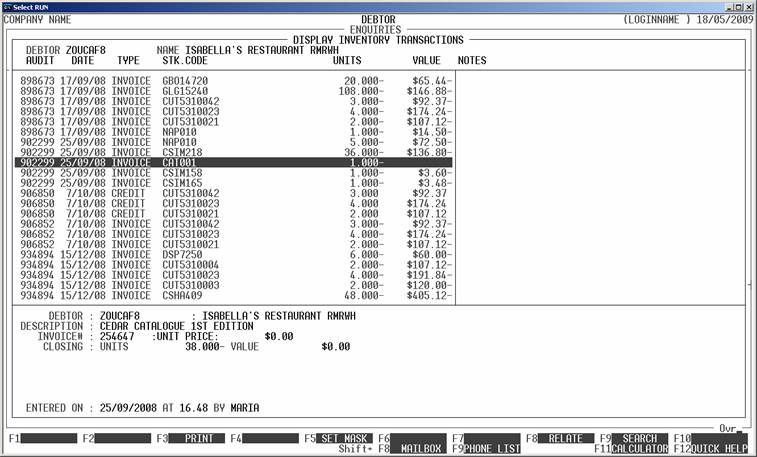
This screen shows the Invoices and Credit-notes, for
all stock codes, that pertain to the current Debtor. This information is useful
for looking for history of sales and prices. Moving around this screen is
similar to searching for a Debtor. This is fully described above. You will also
have several options available via the function keys:
<F3> This will cause HiFinance to initiate a print of
the transactions. You will be given the option to restrict the report to a
range of dates. Other formatting options may also be displayed.
<F4> If your USERCODE allows you to modify notes
via the enquiries screen, HiFinance will either display ADD NOTE or AMEND NOTE, depending in wether the note
is currently blank or not, respectively. If you press <F4>, HiFinance will overlay a window that displays the
note attached to this transaction and allows you to enter your changes.
<F5> This option allows you to set a Mask. The purpose of
this is to restrict the display to a specific Inventory code. If you are trying
to follow the sales of a specific stock code for this Debtor, this function
will filter out all extraneous transactions. To change to a different mask,
press <F5> again. To remove the mask,
ie display all Inventory codes, press <F6>.
<F8> This initiates a search through the transaction
files for all transactions that have the same transaction audit number as the
current record. This is similar to the SEARCH
FOR AUDIT NO function except that you are not prompted for an audit number
because HiFinance already knows which
number to search on. See SECTION 6.5.5.
<F9> This allows you to start the display from a
different period. A window is opened that asks for the year and period.
<ESC> This will return you to the calling program.
Displaying Sales Orders.
If you press <F8> from the Debtor display
screen, you will be able to display any Sales Order (Proforma Invoices) that
relate to the current Debtor. Initially, HiFinance will as you if you wish to
display Active Orders only. If you answer Y, only orders that still
have unfilled lines will be displayed. An N will display all orders.
The screen will appear as follows:
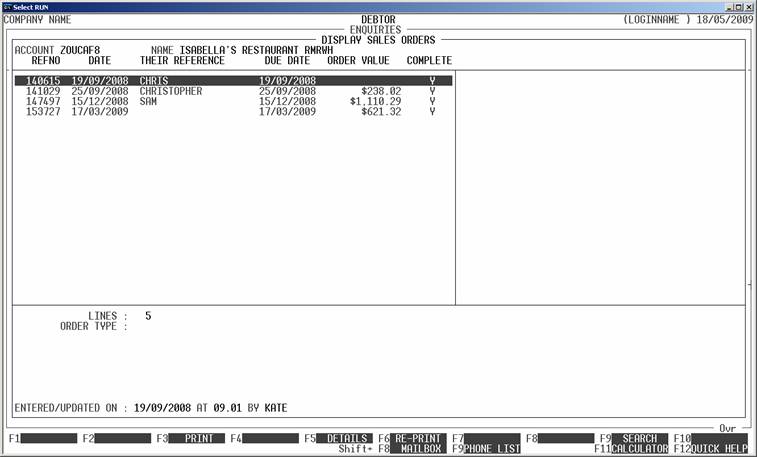
This screen shows the Orders that pertain to the
current Debtor, only. You will also have several options available via the
function keys:
<F3> This will cause HiFinance to initiate a print of
the orders, in a report format. You will be given the option to restrict the
report to a range of dates.
<F5> This option expands the lower part of the screen
and displays the individual lines for the highlighted order. Once in this
function, you will be given the option to print the order details in a report
format, or reprint the order in its normal format.
<F8> This is a special function, which should only be
used sparingly. If you have accidentally completed an order, you can choose to
reinstate it in so that the invoicing routines will recognise it an unfilled order.
There is no mechanism to partially reset an order, so the whole order becomes
available for re-invoicing.
<F9> This allows you to start the display from a
different date.
<ESC> This will return you to the main enquiries .screen.